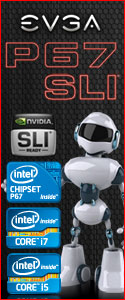We’ll start our tour of the EVGA X58-SLI with a rundown of the specifications for the motherboard.
Specifications
| Size | ATX Form Factor 12 x 9.6 inch |
| Processor Support | Intel Core i7 Support |
| Operating Systems | Supports Windows XP, Vista, Win 7 32/64 bit |
| Chipsets | Intel X58 and ICH10R |
| System Memory Support | Supports Triple Channel JEDEC DDR3-1600+ Officially Supports up to 24GBs of DDR3 Memory |
| USB 2.0 Ports | Supports Hot Plug Twelve USB 2.0 Ports (8-rear panel and 4-onboard headers Supports wake-up from S1 and S3 mode Supports USB 2.0 protocol up to 480 Mbps transmission rate |
| USB 3.0 Ports | Supports hot plug Two USB 3.0 Ports (rear panel) Backwards compatible USB 2.0 and USB 3.0 support Supports transfer speeds up to 5Gbps |
| SATA II | Six onboard Sata II ports 300 MBps data transfer rate Six SATA II connectors from Southbridge w/support for Raid 0, 1, 10, and 5 Supports hot plug and NCQ (native command queuing) |
| SATA III | Two Sata3 6Gbps onboard ports from Marvell 88SE9128 Chipset |
| LAN | Integrated LAN Port Supports 10/100/1000 Mbit/sec Ethernet |
| Firewire | Onboard IEEE1394a Support hot plug Two IEEE1394a ports (two onboard headers) Transmission rate of 400 Mbps |
| Audio | Onboard Realtek High-Definition audio Support 8-Channel audio Supports jack sensing function |
| PCI Express | Three PCI-E 2.0 Slots Supports up to 4 GB/sec concurrent bandwidth Low power consumption and power management features |
| Green Function | Supports ACPI (advanced configuration and power interface) Supports S0 (normal), S1 (power on suspend), S3 (Suspend to ram), S4 (suspend to disk – OS dependent), and S5 (soft-off) |
| Expansion Slots | 1 x PCI slot 2 x PCI Express x1 slots 3 x PCI Express x8/x16 slots |
Next let’s have a look at some full board pictures from the four different angles. We’ll go into more detail of each area next. Of interest here is the picture of the back side of the motherboard, notice all the heatsinks are attached with screws, not push pins!
 |
 |
 |
 |
 |
|
As you can see by the photos above, the X58-SLI3 keeps with EVGA’s X58 theme of a black printed circuit board and black heatsinks. Let’s continue on with a close up look at the motherboard. Beginning at the bottom of the motherboard, we see the built in speaker to the far left and next to that is the onboard reset, power and clear CMOS buttons. There are also a pair of chassis fan headers located in this area. The right side of the bottom of the motherboard is where you will find two Firewire 1394a connections, as well as four USB 2.0 headers. Also visible in this area is the onboard diagnostic LED readout.
 |
 |
The right side of the X58-SLI3 is next on the tour. Here is where the six Intel SATA II ports (Black) and the two SATA III connectors (Red) are located. Because neither the X58 chipset or theICH10R interface support Sata III, the Marvell 88SE9128 chipset was used. The Marvell chipset supports IDE mode as well as raid 0 and Raid 1. Next to the Sata ports you can see yet another fan header, speaking of which there are a total of six fan headers on the X58-SLI3, one 4-pin for the CPU and 5 additional 3-pin. The top of the right side of the motherboard is where you will find the main 24-pin ATX power connection. You will also notice the six DDR3 dimm slots. EVGA provides a sticker on the dimm slots which clearly indicates how the memory should be installed for single, dual or triple channel operation.
 |
 |
 |
Moving along we find ourselves at the top area of the EVGA X58-SLI3. Here you can see the CPU socket area and the voltage readout points (more on this later). The CPU socket area is wide open and should be able to accommodate just about any aftermarket air or water cooling solution. The left side of the top of the motherboard reveals the CPU fan header and a side view of the PWM heatsink.
 |
 |
The left side of the motherboard, or the rear as some like to call it, is a very busy area. This is where you find all the I/O connections such as the 8-Channel HD Audio (Realtek), LAN, Keyboard, and ten (yes we said ten!) USB connections. Two of the USB connections are of the USB 3.0 variety and are distinguishable by the blue color. Also cleverly placed in this area is an additional clear CMOS button which will allow you to clear CMOS without having to remove your case’s side panel. From the same vantage point you can look down the barrel of the PCI slots. There is a PCI-e X16 slot, two PCI-e X8 slots, two PCI-e X1 slots, and a standard PCI slot. If you plan on using Tri-SLI with dual slot video cards you will kill off any chance of using the PCI or PCI-e x1 slots as they will all be covered. Locating one of the PCI-e X1 slots above the first PCI-e X16 slot would have afforded the user at least one additional slot while using Tri-SLI. In our opinion this would only be an issue for those who do not like the Realtek onboard audio and wish to install a sound card of their choosing. You might also notice that the Front Panel Audio connector is precariously located inline with the PCI slot, this could present a problem for some PCI card installations.
 |
 |
 |
There are a few more layout items we would like to discuss before moving on. The first is a feature we absolutely adore, a replaceable BIOS chip. For the hard core overclockers and those who flash their BIOS regularly, there is nothing like the security of having a spare pre flashed BIOS chip at the ready should a flash go south. The spare BIOS chips can be purchased several places around the internet, either blank or pre flashed. Blank BIOS chips can be had for VERY cheap and then simply hot flash it yourself.
The next layout feature we would be remiss if we did not mention is the placement of the 8-Pin CPU power plug. Normally we like to see this connector at the top edge of the motherboard, in this case, the connector is lower down and below the PWM heatsink. While this will make cable management a little more challenging, it’s not really that bad of a location, especially for those with a bottom mount Power Supply that has a shorter lead. So, while it may not be our preferred location, it does increase compatibility with a wider range of Power Supplies.
Finally, another of our favorite features is the voltage readout points that EVGA implemented some time ago. This is another fantastic feature that the overclocking community will put to good use. We all know that the voltage readings we see in the BIOS are not always the most accurate. These readout points should give you a more accurate assessment of the actual voltages being applied to the different components. This is not just a CPU and memory voltage check point, but in fact, almost every BIOS adjustable voltage is readable from these voltage readout points. Just a plain awesome feature!
 |
 |
 |
Last, but not least on our tour of the EVGA X58-SLI3 is our customary look “under the hood”. We removed the three heatsinks from the motherboard to inspect the application of thermal paste and how well they make contact with their intended target. First, we took a look at the Southbridge heatsink. As is the case with every EVGA motherboard we have reviewed, the thermal paste was applied very well and the heatsink was making excellent contact with the chip.
 |
 |
Next we headed for the X58 Northbridge chipset, again the thermal paste application was superb and the heatsink was making great contact.
 |
 |
And finally, we removed the PWM heatsink. EVGA usually uses a thermal pad on these heatsinks and the X58-SLI3 is no different. As you can see by the picture below, all 12 chips left a nice indent in the thermal pad thus indicating excellent contact with the intended target.
 That concludes our up close tour of the EVGA X58-SLI3 motherboard, read on as we fire this bad boy up!
That concludes our up close tour of the EVGA X58-SLI3 motherboard, read on as we fire this bad boy up!

 Posted in
Posted in 





